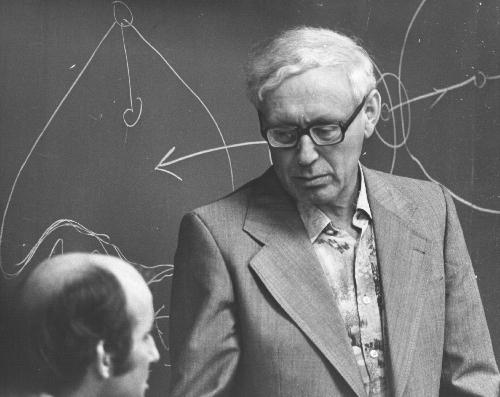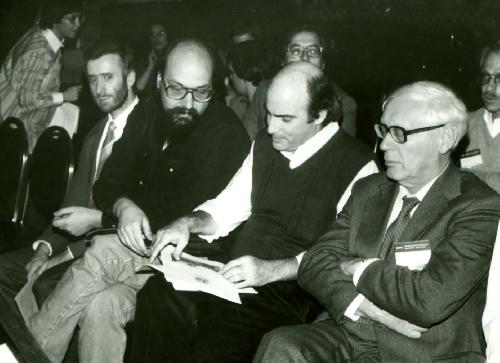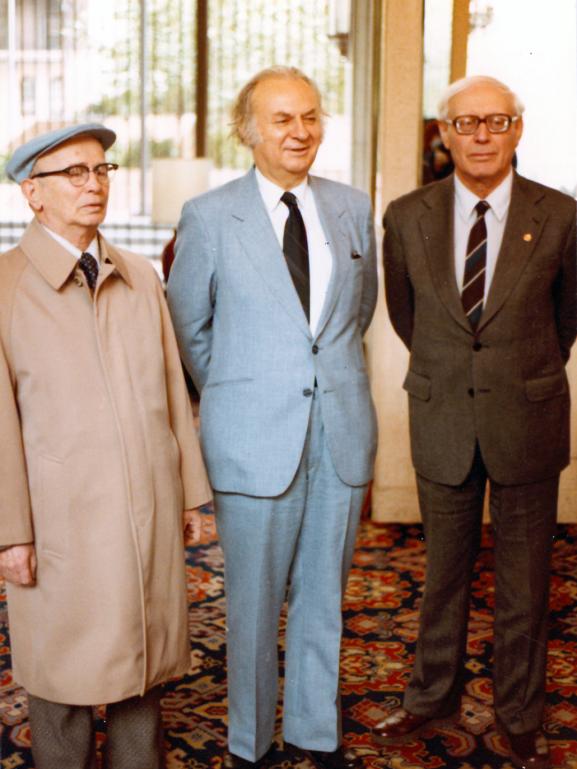Difference between revisions of "Mikhail Botvinnik"
GerdIsenberg (talk | contribs) (Created page with "'''Home * People * Mikhail Botvinnik''' FILE:Mikhail Botvinnik 1962.jpg|border|right|thumb|| Mikhail Botvinnik <ref>Image at [https://en.wikipedia.org/wi...") |
GerdIsenberg (talk | contribs) m |
||
| Line 4: | Line 4: | ||
'''Mikhail Moiseyevich Botvinnik''', (Михаил Ботвинник , August 17, 1911 – May 5, 1995) <br/> | '''Mikhail Moiseyevich Botvinnik''', (Михаил Ботвинник , August 17, 1911 – May 5, 1995) <br/> | ||
| − | was a Russian chess [https://en.wikipedia.org/wiki/Grandmaster_%28chess%29 Grandmaster], three-time [https://en.wikipedia.org/wiki/World_Chess_Championship World Chess Champion] from [https://en.wikipedia.org/wiki/World_Chess_Championship_1948 1948] to [https://en.wikipedia.org/wiki/World_Chess_Championship_1957 1957], [https://en.wikipedia.org/wiki/World_Chess_Championship_1958 1958] to [https://en.wikipedia.org/wiki/World_Chess_Championship_1960 1960], and [https://en.wikipedia.org/wiki/World_Chess_Championship_1961 1961] to [https://en.wikipedia.org/wiki/World_Chess_Championship_1963 1963], and a Doctor of Technical Sciences. Botvinnik’s interest in Computer Chess started in the 50s, favouring chess algorithms based on [[Claude Shannon|Shannon's]] selective [[Type B Strategy|type B strategy]], as discussed along with [[Max Euwe]] 1958 in Dutch Television <ref>[http://www.chessgames.com/perl/chess.pl?tid=81282 Wageningen Caltex (1958)] from [http://www.chessgames.com/index.html chessgames.com]</ref>. Botvinnik served as a consultant to Soviet computer chess developers who developed the [[ITEP Chess Program]] at [https://en.wikipedia.org/wiki/Moscow Moscow's] [[Institute of Theoretical and Experimental Physics]] (ITEP) which won a [[Stanford-ITEP Match|correspondence chess match]] against the [[Kotok-McCarthy-Program]] led by [[John McCarthy]] in 1967. Later he advised the team that created the chess program [[Kaissa]] at Moscow’s [[Institute of Control Sciences]] <ref>[http://www.computerhistory.org/chess/full_record.php?iid=stl-430b9bbdb9817 International Grandmaster and World Champion Mikhail Botvinnik in Moscow], 1980, Gift of [[Monroe Newborn]], "[[Mikhail Botvinnik|Botvinnik]] served as a consultant to Soviet computer chess developers who developed an early program at [[Institute of Theoretical and Experimental Physics|ITEP]] which won a [[Stanford-ITEP Match|correspondence chess match]] against a [[Stanford University]] [[Kotok-McCarthy-Program|chess program]] led by [[John McCarthy]] in 1967. Later he advised the team that created the chess program [[Kaissa]] at [[Institute of Control Sciences|Moscow’s Institute for Control Science]]"</ref> <ref>[http://www.cs.toronto.edu/~brudno/ Michael Brudno] ('''2000'''). ''Competitions, Controversies, and Computer Chess'', [http://www.cs.toronto.edu/%7Ebrudno/essays/cchess.pdf pdf]</ref> <ref>[http://groups.google.com/group/rec.games.chess.computer/browse_frm/thread/e9f5b809a7ac0952 Kaissa & Botvinik] by [[Shay Bushinsky]], [[Computer Chess Forums|rgcc]], October 16, 1997</ref> . | + | was a Russian chess [https://en.wikipedia.org/wiki/Grandmaster_%28chess%29 Grandmaster], three-time [https://en.wikipedia.org/wiki/World_Chess_Championship World Chess Champion] from [https://en.wikipedia.org/wiki/World_Chess_Championship_1948 1948] to [https://en.wikipedia.org/wiki/World_Chess_Championship_1957 1957], [https://en.wikipedia.org/wiki/World_Chess_Championship_1958 1958] to [https://en.wikipedia.org/wiki/World_Chess_Championship_1960 1960], and [https://en.wikipedia.org/wiki/World_Chess_Championship_1961 1961] to [https://en.wikipedia.org/wiki/World_Chess_Championship_1963 1963], and a Doctor of Technical Sciences. |
| + | |||
| + | =Computer Chess= | ||
| + | Botvinnik’s interest in Computer Chess started in the 50s, favouring chess algorithms based on [[Claude Shannon|Shannon's]] selective [[Type B Strategy|type B strategy]], as discussed along with [[Max Euwe]] 1958 in Dutch Television <ref>[http://www.chessgames.com/perl/chess.pl?tid=81282 Wageningen Caltex (1958)] from [http://www.chessgames.com/index.html chessgames.com]</ref>. Botvinnik served as a consultant to Soviet computer chess developers who developed the [[ITEP Chess Program]] at [https://en.wikipedia.org/wiki/Moscow Moscow's] [[Institute of Theoretical and Experimental Physics]] (ITEP) which won a [[Stanford-ITEP Match|correspondence chess match]] against the [[Kotok-McCarthy-Program]] led by [[John McCarthy]] in 1967. Later he advised the team that created the chess program [[Kaissa]] at Moscow’s [[Institute of Control Sciences]] <ref>[http://www.computerhistory.org/chess/full_record.php?iid=stl-430b9bbdb9817 International Grandmaster and World Champion Mikhail Botvinnik in Moscow], 1980, Gift of [[Monroe Newborn]], "[[Mikhail Botvinnik|Botvinnik]] served as a consultant to Soviet computer chess developers who developed an early program at [[Institute of Theoretical and Experimental Physics|ITEP]] which won a [[Stanford-ITEP Match|correspondence chess match]] against a [[Stanford University]] [[Kotok-McCarthy-Program|chess program]] led by [[John McCarthy]] in 1967. Later he advised the team that created the chess program [[Kaissa]] at [[Institute of Control Sciences|Moscow’s Institute for Control Science]]"</ref> <ref>[http://www.cs.toronto.edu/~brudno/ Michael Brudno] ('''2000'''). ''Competitions, Controversies, and Computer Chess'', [http://www.cs.toronto.edu/%7Ebrudno/essays/cchess.pdf pdf]</ref> <ref>[http://groups.google.com/group/rec.games.chess.computer/browse_frm/thread/e9f5b809a7ac0952 Kaissa & Botvinik] by [[Shay Bushinsky]], [[Computer Chess Forums|rgcc]], October 16, 1997</ref> . | ||
However, Botvinnik had his own ideas to model a Chess Master's Mind. After publishing and discussing his early ideas on [[Attack and Defend Maps|attack maps]] and [[Trajectory|trajectories]] at [https://en.wikipedia.org/wiki/Chess_Centres Moscow Central Chess Club] <ref>[http://en.chessbase.com/home/TabId/211/PostId/4007513 The last day of the “Botvinnik Memorial”] by [http://de.wikipedia.org/wiki/Anna_Denissowna_Burtassowa Anna Burtasova], [[ChessBase|ChessBase News]], September 07, 2011</ref> in 1966, with the skeptical [[Georgy Adelson-Velsky]] and others attending, he found [[Vladimir Butenko]] as supporter and collaborator. Butenko first implemented the [[Vector Attacks|15x15 vector attacks]] board representation on a [[M-20]] computer, [[Distance#15x15|determining trajectories]]. After Botvinnik introduced the concept of Zones in 1970, Butenko refused further cooperation and began to write his own [[Butenko's program|program]] <ref>[http://atimopheyev.narod.ru/Frame/index.html Лингвистическая Геометрия] Бориса Штильмана, [http://translate.googleusercontent.com/translate_c?hl=de&ie=UTF8&prev=_t&rurl=translate.google.com&sl=ru&tl=en&u=http://atimopheyev.narod.ru/Frame/index.html&usg=ALkJrhjGqyvJey-MTGqcGxzMU53Od0Y7VQ Linguistic Geometry] [[Boris Stilman]] by [[Alexander Timofeev]] ([https://en.wikipedia.org/wiki/Google_Translate Google Translate]) | However, Botvinnik had his own ideas to model a Chess Master's Mind. After publishing and discussing his early ideas on [[Attack and Defend Maps|attack maps]] and [[Trajectory|trajectories]] at [https://en.wikipedia.org/wiki/Chess_Centres Moscow Central Chess Club] <ref>[http://en.chessbase.com/home/TabId/211/PostId/4007513 The last day of the “Botvinnik Memorial”] by [http://de.wikipedia.org/wiki/Anna_Denissowna_Burtassowa Anna Burtasova], [[ChessBase|ChessBase News]], September 07, 2011</ref> in 1966, with the skeptical [[Georgy Adelson-Velsky]] and others attending, he found [[Vladimir Butenko]] as supporter and collaborator. Butenko first implemented the [[Vector Attacks|15x15 vector attacks]] board representation on a [[M-20]] computer, [[Distance#15x15|determining trajectories]]. After Botvinnik introduced the concept of Zones in 1970, Butenko refused further cooperation and began to write his own [[Butenko's program|program]] <ref>[http://atimopheyev.narod.ru/Frame/index.html Лингвистическая Геометрия] Бориса Штильмана, [http://translate.googleusercontent.com/translate_c?hl=de&ie=UTF8&prev=_t&rurl=translate.google.com&sl=ru&tl=en&u=http://atimopheyev.narod.ru/Frame/index.html&usg=ALkJrhjGqyvJey-MTGqcGxzMU53Od0Y7VQ Linguistic Geometry] [[Boris Stilman]] by [[Alexander Timofeev]] ([https://en.wikipedia.org/wiki/Google_Translate Google Translate]) | ||
[http://atimopheyev.narod.ru/AfterPIONEER/index.html По стопам ПИОНЕРа], [http://translate.googleusercontent.com/translate_c?hl=de&ie=UTF8&prev=_t&rurl=translate.google.com&sl=ru&tl=en&u=http://atimopheyev.narod.ru/AfterPIONEER/index.html&usg=ALkJrhh0I8eGI93tpR27m-YIWUnG3l5SjA In the footsteps of Pioneer]</ref>. | [http://atimopheyev.narod.ru/AfterPIONEER/index.html По стопам ПИОНЕРа], [http://translate.googleusercontent.com/translate_c?hl=de&ie=UTF8&prev=_t&rurl=translate.google.com&sl=ru&tl=en&u=http://atimopheyev.narod.ru/AfterPIONEER/index.html&usg=ALkJrhh0I8eGI93tpR27m-YIWUnG3l5SjA In the footsteps of Pioneer]</ref>. | ||
| − | =Pioneer= | + | ==Pioneer== |
In the 70s and 80s, leading a team around [[Boris Stilman]], [[Alexander Yudin]], [[Alexander Reznitskiy]], [[Michael Tsfasman]] and [[Mikhail Chudakov]], Botvinnik worked on his own project [[Pioneer]]. The research and work on Pioneer took place at the ''State Committee for Science and Technology'', [https://en.wikipedia.org/wiki/Moscow Moscow], [https://en.wikipedia.org/wiki/Soviet_Union USSR], the ''National Research Institute for Electrical Engineering'', Moscow, USSR and the [https://en.wikipedia.org/wiki/Russian_Academy_of_Sciences USSR Academy of Sciences], Moscow, USSR. Short time visits with Stilman and Yudin took place in 1978 at [https://en.wikipedia.org/wiki/University_of_Mannheim University of Mannheim], Germany, and the [[University of Dortmund]], Germany, as well at [https://en.wikipedia.org/wiki/Control_Data_Corporation Control Data Corp.], USA. Based on this research, Boris Stilman coined the term [[Linguistic Geometry]] <ref>[http://www.stilman-strategies.com/bstilman/lgmain.html The Home Page of Linguistic Geometry] by [[Boris Stilman]]</ref>, a new type of game theory. Botvinnik published Pioneer's abilities on selected positions, but it never played a public complete game of chess. | In the 70s and 80s, leading a team around [[Boris Stilman]], [[Alexander Yudin]], [[Alexander Reznitskiy]], [[Michael Tsfasman]] and [[Mikhail Chudakov]], Botvinnik worked on his own project [[Pioneer]]. The research and work on Pioneer took place at the ''State Committee for Science and Technology'', [https://en.wikipedia.org/wiki/Moscow Moscow], [https://en.wikipedia.org/wiki/Soviet_Union USSR], the ''National Research Institute for Electrical Engineering'', Moscow, USSR and the [https://en.wikipedia.org/wiki/Russian_Academy_of_Sciences USSR Academy of Sciences], Moscow, USSR. Short time visits with Stilman and Yudin took place in 1978 at [https://en.wikipedia.org/wiki/University_of_Mannheim University of Mannheim], Germany, and the [[University of Dortmund]], Germany, as well at [https://en.wikipedia.org/wiki/Control_Data_Corporation Control Data Corp.], USA. Based on this research, Boris Stilman coined the term [[Linguistic Geometry]] <ref>[http://www.stilman-strategies.com/bstilman/lgmain.html The Home Page of Linguistic Geometry] by [[Boris Stilman]]</ref>, a new type of game theory. Botvinnik published Pioneer's abilities on selected positions, but it never played a public complete game of chess. | ||
| − | =CC Sapiens= | + | ==CC Sapiens== |
In the 90s, Botvinnik already in his 80s, he worked on the new project [[CC Sapiens]], in collaboration with [[Vasily Vladimirov]], [[Evgeniĭ Dmitrievich Cherevik]] and [[Vitaly Vygodsky]] <ref>[[Mikhail Botvinnik]], [[Evgeniĭ Dmitrievich Cherevik]], [[Vasily Vladimirov]], [[Vitaly Vygodsky]] ('''1994'''). ''[https://getinfo.de/app/Solving-Shannon-s-Problem-Ways-and-Means/id/BLCP%3ACN011979464 Solving Shannon's Problem: Ways and Means]''. [[Advances in Computer Chess 7]]</ref>. For his publication ''Three Positions'' <ref>[[Mikhail Botvinnik]] ('''1993'''). ''Three Positions''. [[ICGA Journal#16_2|ICCA Journal, Vol. 16, No. 2]]</ref> , Botvinnik was criticized by [[Hans Berliner]] <ref>[[Hans Berliner]] ('''1993'''). ''Playing Computer Chess in the Human Style''. [[ICGA Journal#16_3|ICCA Journal, Vol. 16, No. 3]]</ref> <ref>[http://groups.google.com/group/rec.games.chess/browse_frm/thread/c6c81bbb1a2b399f# Kasparov missed Beautiful win; Botvinnik's Program muffs analysis] by [[Hans Berliner]], [[Computer Chess Forums|rec.games.chess]], July 9, 1993</ref> <ref>[https://groups.google.com/d/msg/rec.games.chess/k4GtEUygkcA/2InGGoEXHAAJ Berliner paper about Botvinnik] by [[Shane Hudson]], [[Computer Chess Forums|rgc]], September 10, 1994</ref> <ref>[https://groups.google.com/d/msg/rec.games.chess.computer/ZWQ5ZwvXx_s/EgXPrz6jZFYJ Botvinnik article] by [[Jonathan Schaeffer]], [[Computer Chess Forums|rgcc]], October 23, 1996</ref> <ref>[http://atimopheyev.narod.ru/AfterPIONEER/info/PIONEER/2-Berliner.htm Hans Berliner against Mikhail Botvinnik] by [[Alexander Timofeev]]</ref>, and his old chess rival [[David Bronstein]] <ref>[[David Bronstein]] ('''1993'''). ''Mimicking Human Oversight''. [[ICGA Journal#16_3|ICCA Journal, Vol. 16, No. 3]]</ref>. | In the 90s, Botvinnik already in his 80s, he worked on the new project [[CC Sapiens]], in collaboration with [[Vasily Vladimirov]], [[Evgeniĭ Dmitrievich Cherevik]] and [[Vitaly Vygodsky]] <ref>[[Mikhail Botvinnik]], [[Evgeniĭ Dmitrievich Cherevik]], [[Vasily Vladimirov]], [[Vitaly Vygodsky]] ('''1994'''). ''[https://getinfo.de/app/Solving-Shannon-s-Problem-Ways-and-Means/id/BLCP%3ACN011979464 Solving Shannon's Problem: Ways and Means]''. [[Advances in Computer Chess 7]]</ref>. For his publication ''Three Positions'' <ref>[[Mikhail Botvinnik]] ('''1993'''). ''Three Positions''. [[ICGA Journal#16_2|ICCA Journal, Vol. 16, No. 2]]</ref> , Botvinnik was criticized by [[Hans Berliner]] <ref>[[Hans Berliner]] ('''1993'''). ''Playing Computer Chess in the Human Style''. [[ICGA Journal#16_3|ICCA Journal, Vol. 16, No. 3]]</ref> <ref>[http://groups.google.com/group/rec.games.chess/browse_frm/thread/c6c81bbb1a2b399f# Kasparov missed Beautiful win; Botvinnik's Program muffs analysis] by [[Hans Berliner]], [[Computer Chess Forums|rec.games.chess]], July 9, 1993</ref> <ref>[https://groups.google.com/d/msg/rec.games.chess/k4GtEUygkcA/2InGGoEXHAAJ Berliner paper about Botvinnik] by [[Shane Hudson]], [[Computer Chess Forums|rgc]], September 10, 1994</ref> <ref>[https://groups.google.com/d/msg/rec.games.chess.computer/ZWQ5ZwvXx_s/EgXPrz6jZFYJ Botvinnik article] by [[Jonathan Schaeffer]], [[Computer Chess Forums|rgcc]], October 23, 1996</ref> <ref>[http://atimopheyev.narod.ru/AfterPIONEER/info/PIONEER/2-Berliner.htm Hans Berliner against Mikhail Botvinnik] by [[Alexander Timofeev]]</ref>, and his old chess rival [[David Bronstein]] <ref>[[David Bronstein]] ('''1993'''). ''Mimicking Human Oversight''. [[ICGA Journal#16_3|ICCA Journal, Vol. 16, No. 3]]</ref>. | ||
Revision as of 17:11, 13 May 2018
Home * People * Mikhail Botvinnik

Mikhail Moiseyevich Botvinnik, (Михаил Ботвинник , August 17, 1911 – May 5, 1995)
was a Russian chess Grandmaster, three-time World Chess Champion from 1948 to 1957, 1958 to 1960, and 1961 to 1963, and a Doctor of Technical Sciences.
Contents
Computer Chess
Botvinnik’s interest in Computer Chess started in the 50s, favouring chess algorithms based on Shannon's selective type B strategy, as discussed along with Max Euwe 1958 in Dutch Television [2]. Botvinnik served as a consultant to Soviet computer chess developers who developed the ITEP Chess Program at Moscow's Institute of Theoretical and Experimental Physics (ITEP) which won a correspondence chess match against the Kotok-McCarthy-Program led by John McCarthy in 1967. Later he advised the team that created the chess program Kaissa at Moscow’s Institute of Control Sciences [3] [4] [5] .
However, Botvinnik had his own ideas to model a Chess Master's Mind. After publishing and discussing his early ideas on attack maps and trajectories at Moscow Central Chess Club [6] in 1966, with the skeptical Georgy Adelson-Velsky and others attending, he found Vladimir Butenko as supporter and collaborator. Butenko first implemented the 15x15 vector attacks board representation on a M-20 computer, determining trajectories. After Botvinnik introduced the concept of Zones in 1970, Butenko refused further cooperation and began to write his own program [7].
Pioneer
In the 70s and 80s, leading a team around Boris Stilman, Alexander Yudin, Alexander Reznitskiy, Michael Tsfasman and Mikhail Chudakov, Botvinnik worked on his own project Pioneer. The research and work on Pioneer took place at the State Committee for Science and Technology, Moscow, USSR, the National Research Institute for Electrical Engineering, Moscow, USSR and the USSR Academy of Sciences, Moscow, USSR. Short time visits with Stilman and Yudin took place in 1978 at University of Mannheim, Germany, and the University of Dortmund, Germany, as well at Control Data Corp., USA. Based on this research, Boris Stilman coined the term Linguistic Geometry [8], a new type of game theory. Botvinnik published Pioneer's abilities on selected positions, but it never played a public complete game of chess.
CC Sapiens
In the 90s, Botvinnik already in his 80s, he worked on the new project CC Sapiens, in collaboration with Vasily Vladimirov, Evgeniĭ Dmitrievich Cherevik and Vitaly Vygodsky [9]. For his publication Three Positions [10] , Botvinnik was criticized by Hans Berliner [11] [12] [13] [14] [15], and his old chess rival David Bronstein [16].
Photos
Botvinnik's Lecture at McGill University 1977 - any questions? Monty Newborn left [17]
Don Beal, Ken Thompson, Monty Newborn, and Mikhail Botvinnik, WCCC 1983
Samuel Reshevsky, Reuben Fine and Mikhail Botvinnik, WCCC 1983
See also
Publications
Computer Chess
- Mikhail Botvinnik (1968). Algoritm igry v shakhmaty. (The algorithm of chess)
- Mikhail Botvinnik (1970). Computers, Chess and Long-Range Planning. Springer, reviews from goodreads [19] [20]
- Mikhail Botvinnik (1975). O Kiberneticheskoi Celi Igri. (On the Cybernetic Goal of Games), Soviet Radio, Moscow
- Mikhail Botvinnik (1979). O Reshenii Netochnih Prebornih Zadach. (On Solving Inexact Search Problems), Soviet Radio, Moscow
- Mikhail Botvinnik, Boris Stilman, Alexander Yudin, Alexander Reznitskiy, Michael Tsfasman (1980). Thinking of Man and Computer, Proc. of the Second International Meeting on Artificial Intelligence, pp. 1-9, Repino, Leningrad, Russia.
- Mikhail Botvinnik (1982). Decision Making and Computers. Advances in Computer Chess 3
- Mikhail Botvinnik (1982). Meine neuen Ideen zur Schachprogrammierung. Springer-Verlag, Berlin. amazon.de (German)
- Mikhail Botvinnik (1984). Computers in Chess: Solving Inexact Search Problems. Springer
- Mikhail Botvinnik (1983). The Game of Chess: Its past, present and future. ICCA Journal, Vol. 6, No. 3
- Mikhail Botvinnik (1993). Three Positions. ICCA Journal, Vol. 16, No. 2 » Réti Endgame Study [21]
- Mikhail Botvinnik, Evgeniĭ Dmitrievich Cherevik, Vasily Vladimirov, Vitaly Vygodsky (1994). Solving Shannon's Problem: Ways and Means. Advances in Computer Chess 7
- Marty Hirsch (1995). Botwinnik und die Schachprogrammierung. Computerschach und Spiele, June-July 1995 (German)
Misc
- Bob Herschberg, Jaap van den Herik (1995). Mikhail Moiseivich Botvinnik: An Obituary. ICCA Journal, Vol. 18, No. 2
- Monroe Newborn (1995). A Eulogy for Mikhail Moiseivich Botvinnik. ICCA Journal, Vol. 18, No. 2
- Jan van Reek (1998). Michail Botwinnik. Schaakspelers als Eindspelkunstenaars. Deel 7. Stichting Eindspel, Margraten. ISBN 90-74827-37-3
- Michael A. Hudson (2013). Storming Fortresses: A Political History of Chess in the Soviet Union, 1917-1948. Ph.D. thesis, University of California, Santa Cruz, eScholarship, Chapter Ten - Botvinnik: The New Soviet (Chess)Man
Forum Posts
- Kasparov missed Beautiful win; Botvinnik's Program muffs analysis by Hans Berliner, rec.games.chess, July 9, 1993
- Botvinnik article by Jonathan Schaeffer, rgcc, October 23, 1996
- Re: Botvinnik article by Peter Gillgasch, rgcc, October 23, 1996
- Re: Botvinnik article by Marc-François Baudot, rgcc, November 07, 1996 » Advances in Computer Chess 7
- Botvinniks Chess Algorithm ?? by Bruce Moreland, rgcc, October 05, 1997
- Kaissa & Botvinik by Shay Bushinsky, rgcc, October 16, 1997
- What is Botvinnik's legacy to computer chess? by Drazen Marovic, CCC, February 20, 2000
- "The Tale of a Small Tree" by M.M.Botvinnik [fragment] by José Antônio Fabiano Mendes, CCC, March 09, 2000 » Réti Endgame Study
- М. Ботвинник. Проект "ПИОНЕР" by Kashchey the Deathless, immortalchess, March 10, 2010, (Botvinnik. The "Pioneer" translated by Google_Translate)
- Botvinnik mastery by Lyudmil Tsvetkov, CCC, August 09, 2013
External Links
- Mikhail Botvinnik from Wikipedia
- Лингвистическая Геометрия Бориса Штильмана, Linguistic Geometry Boris Stilman by Alexander Timofeev (Google Translate)
- Энциклопедия шахмат - Ботвинник В.Линдер, И.Линдер, The Encyclopedia of Chess - Botvinnik B. Linder, J. Linder
- По стопам ПИОНЕРа, In the footsteps of Pioneer
- Mikhail Botvinnik – Russiapedia
- The chess games of Mikhail Botvinnik from chessgames.com
- Mikhail Botvinnik from The Computer History Museum
- Über Stand und Entwicklung seines Computer-Schachprogramms "Pionier" referierte Prof. Michael Botwinnik (67), UdSSR, auf einer einwöchigen Vortragsreise durch die Bundesrepublik, April 04, 1978, Computerwoche 15/1978 (German)
- The wrong bishop – part two by Frederic Friedel, ChessBase News, May 22, 2016 » Cray Blitz, WCCC 1983, Wrong color Bishop and rook pawn
- Михаил Ботвинник. Осень шахматиста (1990), YouTube Videos
References
- ↑ Image at Schiphol, October 29, 1962, by Harry Pot / Anefo, Mikhail Botvinnik from Wikipedia
- ↑ Wageningen Caltex (1958) from chessgames.com
- ↑ International Grandmaster and World Champion Mikhail Botvinnik in Moscow, 1980, Gift of Monroe Newborn, "Botvinnik served as a consultant to Soviet computer chess developers who developed an early program at ITEP which won a correspondence chess match against a Stanford University chess program led by John McCarthy in 1967. Later he advised the team that created the chess program Kaissa at Moscow’s Institute for Control Science"
- ↑ Michael Brudno (2000). Competitions, Controversies, and Computer Chess, pdf
- ↑ Kaissa & Botvinik by Shay Bushinsky, rgcc, October 16, 1997
- ↑ The last day of the “Botvinnik Memorial” by Anna Burtasova, ChessBase News, September 07, 2011
- ↑ Лингвистическая Геометрия Бориса Штильмана, Linguistic Geometry Boris Stilman by Alexander Timofeev (Google Translate) По стопам ПИОНЕРа, In the footsteps of Pioneer
- ↑ The Home Page of Linguistic Geometry by Boris Stilman
- ↑ Mikhail Botvinnik, Evgeniĭ Dmitrievich Cherevik, Vasily Vladimirov, Vitaly Vygodsky (1994). Solving Shannon's Problem: Ways and Means. Advances in Computer Chess 7
- ↑ Mikhail Botvinnik (1993). Three Positions. ICCA Journal, Vol. 16, No. 2
- ↑ Hans Berliner (1993). Playing Computer Chess in the Human Style. ICCA Journal, Vol. 16, No. 3
- ↑ Kasparov missed Beautiful win; Botvinnik's Program muffs analysis by Hans Berliner, rec.games.chess, July 9, 1993
- ↑ Berliner paper about Botvinnik by Shane Hudson, rgc, September 10, 1994
- ↑ Botvinnik article by Jonathan Schaeffer, rgcc, October 23, 1996
- ↑ Hans Berliner against Mikhail Botvinnik by Alexander Timofeev
- ↑ David Bronstein (1993). Mimicking Human Oversight. ICCA Journal, Vol. 16, No. 3
- ↑ Photos by Monroe Newborn from The Computer History Museum
- ↑ ICGA Reference Database (pdf)
- ↑ Paul Rushton, Tony Marsland (1973). Current Chess Programs: A Summary of their Potential and Limitations. INFOR Journal of the Canadian Information Processing Society Vol. 11, No. 1, pdf
- ↑ Computers, Chess and Long-range Planning by Botvinnik by John L. Jerz
- ↑ "The Tale of a Small Tree" by M.M.Botvinnik [fragment] by José Antônio Fabiano Mendes, CCC, March 09, 2000


